Decision-Making: Rationality Versus Reality in Business Leadership
VerifiedAdded on 2023/06/04
|7
|2418
|77
Essay
AI Summary
This essay delves into the critical aspects of decision-making, contrasting the theoretical ideals of rationality with the practical realities of leadership. It examines the evolution of decision-making models, from economic rationality to bounded rationality, highlighting how leaders employ rational processes to identify problems and evaluate alternatives. The essay explores the influence of heuristics, such as representative and availability heuristics, on decision-making. It emphasizes that decision-making occurs within a broader context of objectives, often under stressful conditions and influenced by organizational structures and cultural backgrounds. The study adopts ethics as a discipline for analyzing decision-making, recognizing that many business decisions have ethical implications. The essay concludes by asserting the importance of informed and structured decision-making to mitigate risks and promote organizational success. It also highlights the role of attribution theory in evaluating the decision process.
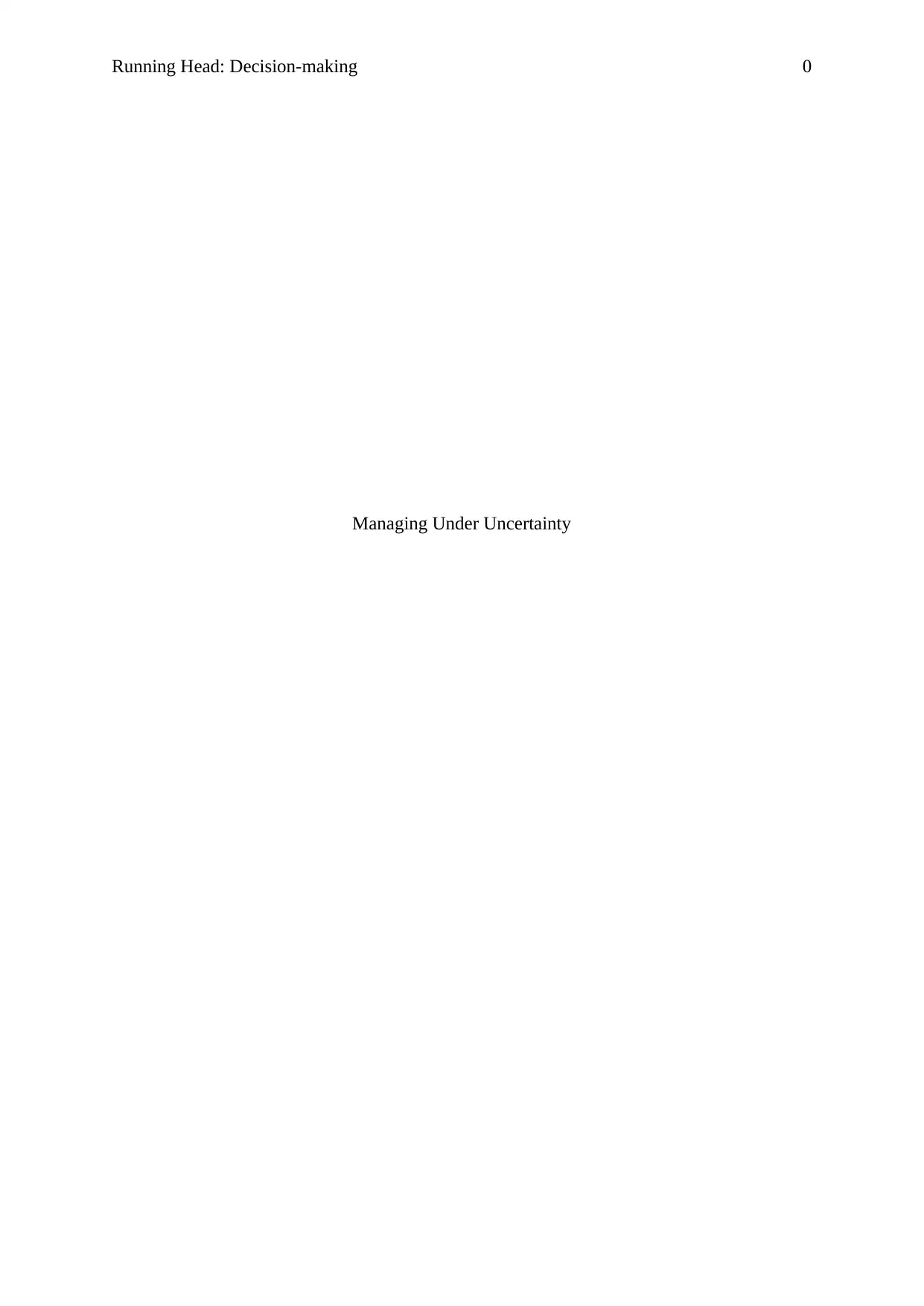
Running Head: Decision-making 0
Managing Under Uncertainty
Managing Under Uncertainty
Paraphrase This Document
Need a fresh take? Get an instant paraphrase of this document with our AI Paraphraser
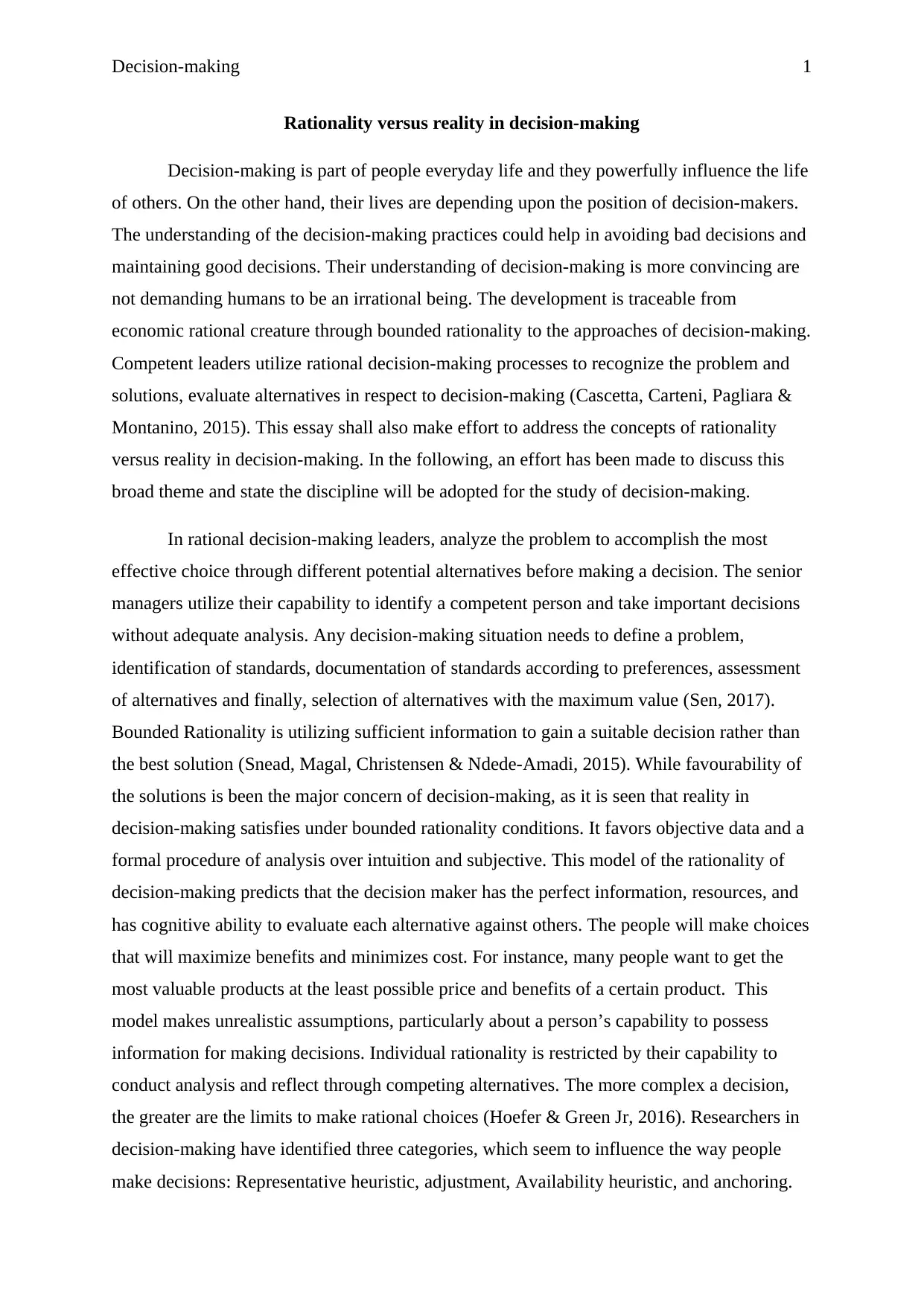
Decision-making 1
Rationality versus reality in decision-making
Decision-making is part of people everyday life and they powerfully influence the life
of others. On the other hand, their lives are depending upon the position of decision-makers.
The understanding of the decision-making practices could help in avoiding bad decisions and
maintaining good decisions. Their understanding of decision-making is more convincing are
not demanding humans to be an irrational being. The development is traceable from
economic rational creature through bounded rationality to the approaches of decision-making.
Competent leaders utilize rational decision-making processes to recognize the problem and
solutions, evaluate alternatives in respect to decision-making (Cascetta, Carteni, Pagliara &
Montanino, 2015). This essay shall also make effort to address the concepts of rationality
versus reality in decision-making. In the following, an effort has been made to discuss this
broad theme and state the discipline will be adopted for the study of decision-making.
In rational decision-making leaders, analyze the problem to accomplish the most
effective choice through different potential alternatives before making a decision. The senior
managers utilize their capability to identify a competent person and take important decisions
without adequate analysis. Any decision-making situation needs to define a problem,
identification of standards, documentation of standards according to preferences, assessment
of alternatives and finally, selection of alternatives with the maximum value (Sen, 2017).
Bounded Rationality is utilizing sufficient information to gain a suitable decision rather than
the best solution (Snead, Magal, Christensen & Ndede-Amadi, 2015). While favourability of
the solutions is been the major concern of decision-making, as it is seen that reality in
decision-making satisfies under bounded rationality conditions. It favors objective data and a
formal procedure of analysis over intuition and subjective. This model of the rationality of
decision-making predicts that the decision maker has the perfect information, resources, and
has cognitive ability to evaluate each alternative against others. The people will make choices
that will maximize benefits and minimizes cost. For instance, many people want to get the
most valuable products at the least possible price and benefits of a certain product. This
model makes unrealistic assumptions, particularly about a person’s capability to possess
information for making decisions. Individual rationality is restricted by their capability to
conduct analysis and reflect through competing alternatives. The more complex a decision,
the greater are the limits to make rational choices (Hoefer & Green Jr, 2016). Researchers in
decision-making have identified three categories, which seem to influence the way people
make decisions: Representative heuristic, adjustment, Availability heuristic, and anchoring.
Rationality versus reality in decision-making
Decision-making is part of people everyday life and they powerfully influence the life
of others. On the other hand, their lives are depending upon the position of decision-makers.
The understanding of the decision-making practices could help in avoiding bad decisions and
maintaining good decisions. Their understanding of decision-making is more convincing are
not demanding humans to be an irrational being. The development is traceable from
economic rational creature through bounded rationality to the approaches of decision-making.
Competent leaders utilize rational decision-making processes to recognize the problem and
solutions, evaluate alternatives in respect to decision-making (Cascetta, Carteni, Pagliara &
Montanino, 2015). This essay shall also make effort to address the concepts of rationality
versus reality in decision-making. In the following, an effort has been made to discuss this
broad theme and state the discipline will be adopted for the study of decision-making.
In rational decision-making leaders, analyze the problem to accomplish the most
effective choice through different potential alternatives before making a decision. The senior
managers utilize their capability to identify a competent person and take important decisions
without adequate analysis. Any decision-making situation needs to define a problem,
identification of standards, documentation of standards according to preferences, assessment
of alternatives and finally, selection of alternatives with the maximum value (Sen, 2017).
Bounded Rationality is utilizing sufficient information to gain a suitable decision rather than
the best solution (Snead, Magal, Christensen & Ndede-Amadi, 2015). While favourability of
the solutions is been the major concern of decision-making, as it is seen that reality in
decision-making satisfies under bounded rationality conditions. It favors objective data and a
formal procedure of analysis over intuition and subjective. This model of the rationality of
decision-making predicts that the decision maker has the perfect information, resources, and
has cognitive ability to evaluate each alternative against others. The people will make choices
that will maximize benefits and minimizes cost. For instance, many people want to get the
most valuable products at the least possible price and benefits of a certain product. This
model makes unrealistic assumptions, particularly about a person’s capability to possess
information for making decisions. Individual rationality is restricted by their capability to
conduct analysis and reflect through competing alternatives. The more complex a decision,
the greater are the limits to make rational choices (Hoefer & Green Jr, 2016). Researchers in
decision-making have identified three categories, which seem to influence the way people
make decisions: Representative heuristic, adjustment, Availability heuristic, and anchoring.
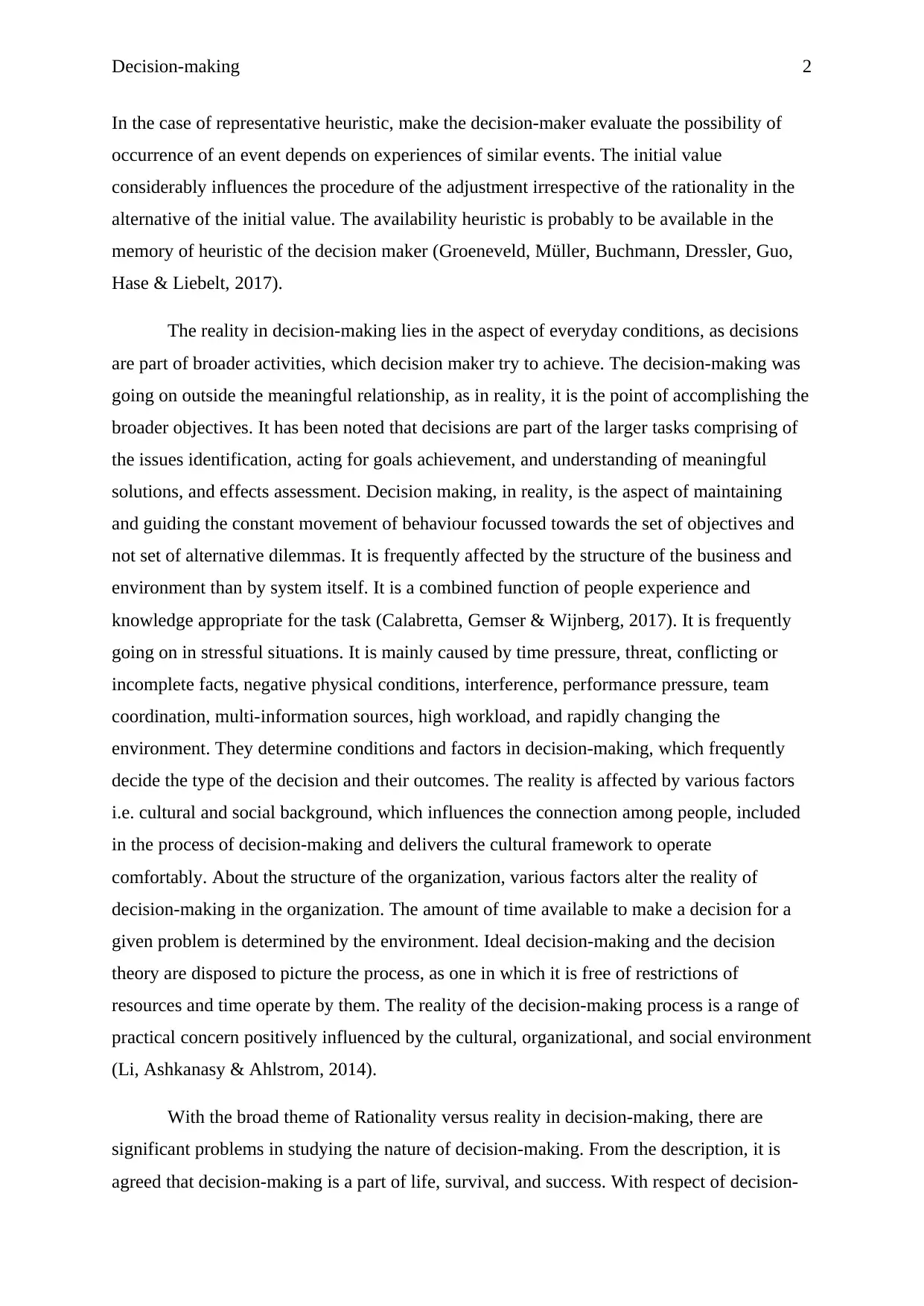
Decision-making 2
In the case of representative heuristic, make the decision-maker evaluate the possibility of
occurrence of an event depends on experiences of similar events. The initial value
considerably influences the procedure of the adjustment irrespective of the rationality in the
alternative of the initial value. The availability heuristic is probably to be available in the
memory of heuristic of the decision maker (Groeneveld, Müller, Buchmann, Dressler, Guo,
Hase & Liebelt, 2017).
The reality in decision-making lies in the aspect of everyday conditions, as decisions
are part of broader activities, which decision maker try to achieve. The decision-making was
going on outside the meaningful relationship, as in reality, it is the point of accomplishing the
broader objectives. It has been noted that decisions are part of the larger tasks comprising of
the issues identification, acting for goals achievement, and understanding of meaningful
solutions, and effects assessment. Decision making, in reality, is the aspect of maintaining
and guiding the constant movement of behaviour focussed towards the set of objectives and
not set of alternative dilemmas. It is frequently affected by the structure of the business and
environment than by system itself. It is a combined function of people experience and
knowledge appropriate for the task (Calabretta, Gemser & Wijnberg, 2017). It is frequently
going on in stressful situations. It is mainly caused by time pressure, threat, conflicting or
incomplete facts, negative physical conditions, interference, performance pressure, team
coordination, multi-information sources, high workload, and rapidly changing the
environment. They determine conditions and factors in decision-making, which frequently
decide the type of the decision and their outcomes. The reality is affected by various factors
i.e. cultural and social background, which influences the connection among people, included
in the process of decision-making and delivers the cultural framework to operate
comfortably. About the structure of the organization, various factors alter the reality of
decision-making in the organization. The amount of time available to make a decision for a
given problem is determined by the environment. Ideal decision-making and the decision
theory are disposed to picture the process, as one in which it is free of restrictions of
resources and time operate by them. The reality of the decision-making process is a range of
practical concern positively influenced by the cultural, organizational, and social environment
(Li, Ashkanasy & Ahlstrom, 2014).
With the broad theme of Rationality versus reality in decision-making, there are
significant problems in studying the nature of decision-making. From the description, it is
agreed that decision-making is a part of life, survival, and success. With respect of decision-
In the case of representative heuristic, make the decision-maker evaluate the possibility of
occurrence of an event depends on experiences of similar events. The initial value
considerably influences the procedure of the adjustment irrespective of the rationality in the
alternative of the initial value. The availability heuristic is probably to be available in the
memory of heuristic of the decision maker (Groeneveld, Müller, Buchmann, Dressler, Guo,
Hase & Liebelt, 2017).
The reality in decision-making lies in the aspect of everyday conditions, as decisions
are part of broader activities, which decision maker try to achieve. The decision-making was
going on outside the meaningful relationship, as in reality, it is the point of accomplishing the
broader objectives. It has been noted that decisions are part of the larger tasks comprising of
the issues identification, acting for goals achievement, and understanding of meaningful
solutions, and effects assessment. Decision making, in reality, is the aspect of maintaining
and guiding the constant movement of behaviour focussed towards the set of objectives and
not set of alternative dilemmas. It is frequently affected by the structure of the business and
environment than by system itself. It is a combined function of people experience and
knowledge appropriate for the task (Calabretta, Gemser & Wijnberg, 2017). It is frequently
going on in stressful situations. It is mainly caused by time pressure, threat, conflicting or
incomplete facts, negative physical conditions, interference, performance pressure, team
coordination, multi-information sources, high workload, and rapidly changing the
environment. They determine conditions and factors in decision-making, which frequently
decide the type of the decision and their outcomes. The reality is affected by various factors
i.e. cultural and social background, which influences the connection among people, included
in the process of decision-making and delivers the cultural framework to operate
comfortably. About the structure of the organization, various factors alter the reality of
decision-making in the organization. The amount of time available to make a decision for a
given problem is determined by the environment. Ideal decision-making and the decision
theory are disposed to picture the process, as one in which it is free of restrictions of
resources and time operate by them. The reality of the decision-making process is a range of
practical concern positively influenced by the cultural, organizational, and social environment
(Li, Ashkanasy & Ahlstrom, 2014).
With the broad theme of Rationality versus reality in decision-making, there are
significant problems in studying the nature of decision-making. From the description, it is
agreed that decision-making is a part of life, survival, and success. With respect of decision-
⊘ This is a preview!⊘
Do you want full access?
Subscribe today to unlock all pages.

Trusted by 1+ million students worldwide
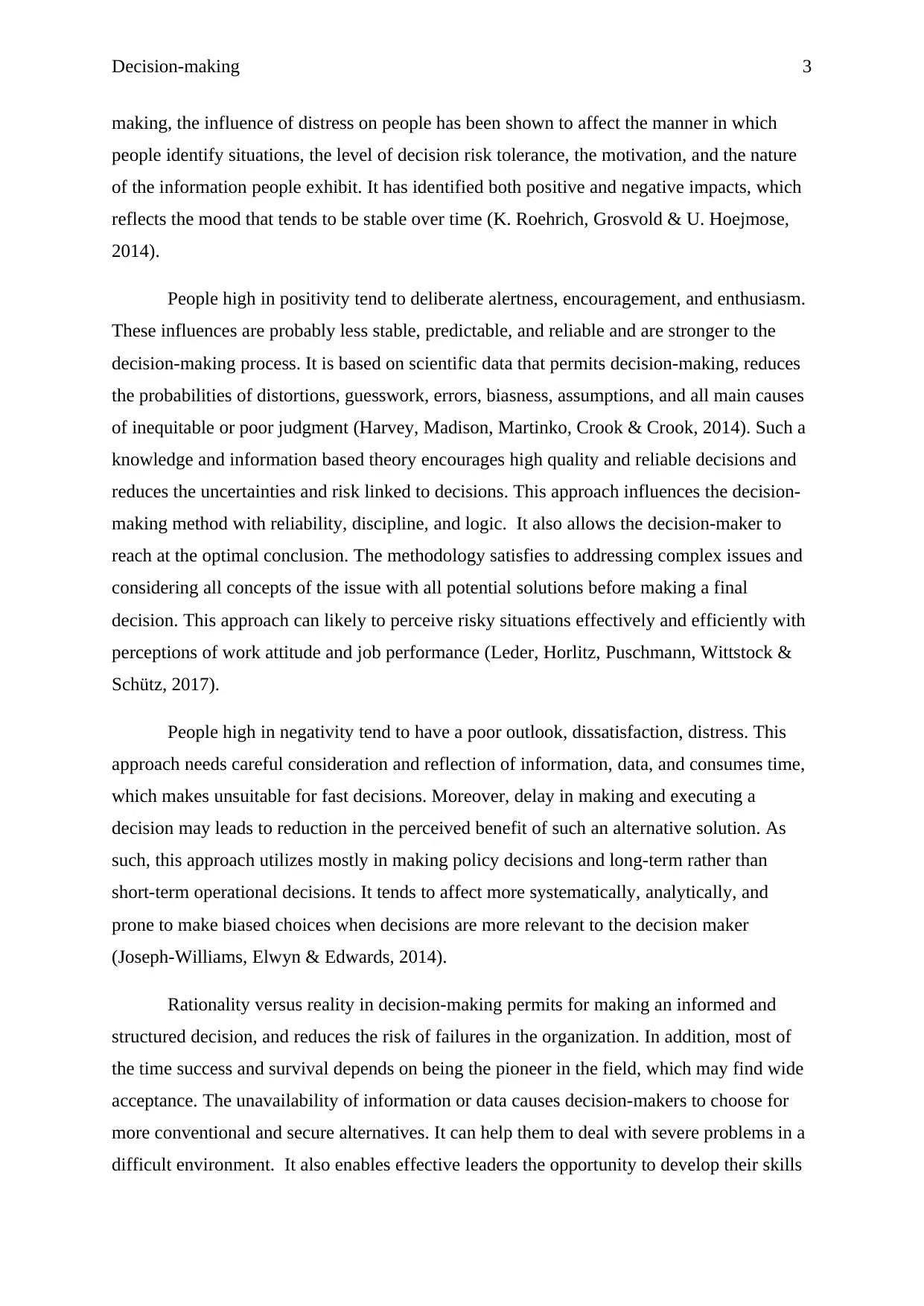
Decision-making 3
making, the influence of distress on people has been shown to affect the manner in which
people identify situations, the level of decision risk tolerance, the motivation, and the nature
of the information people exhibit. It has identified both positive and negative impacts, which
reflects the mood that tends to be stable over time (K. Roehrich, Grosvold & U. Hoejmose,
2014).
People high in positivity tend to deliberate alertness, encouragement, and enthusiasm.
These influences are probably less stable, predictable, and reliable and are stronger to the
decision-making process. It is based on scientific data that permits decision-making, reduces
the probabilities of distortions, guesswork, errors, biasness, assumptions, and all main causes
of inequitable or poor judgment (Harvey, Madison, Martinko, Crook & Crook, 2014). Such a
knowledge and information based theory encourages high quality and reliable decisions and
reduces the uncertainties and risk linked to decisions. This approach influences the decision-
making method with reliability, discipline, and logic. It also allows the decision-maker to
reach at the optimal conclusion. The methodology satisfies to addressing complex issues and
considering all concepts of the issue with all potential solutions before making a final
decision. This approach can likely to perceive risky situations effectively and efficiently with
perceptions of work attitude and job performance (Leder, Horlitz, Puschmann, Wittstock &
Schütz, 2017).
People high in negativity tend to have a poor outlook, dissatisfaction, distress. This
approach needs careful consideration and reflection of information, data, and consumes time,
which makes unsuitable for fast decisions. Moreover, delay in making and executing a
decision may leads to reduction in the perceived benefit of such an alternative solution. As
such, this approach utilizes mostly in making policy decisions and long-term rather than
short-term operational decisions. It tends to affect more systematically, analytically, and
prone to make biased choices when decisions are more relevant to the decision maker
(Joseph-Williams, Elwyn & Edwards, 2014).
Rationality versus reality in decision-making permits for making an informed and
structured decision, and reduces the risk of failures in the organization. In addition, most of
the time success and survival depends on being the pioneer in the field, which may find wide
acceptance. The unavailability of information or data causes decision-makers to choose for
more conventional and secure alternatives. It can help them to deal with severe problems in a
difficult environment. It also enables effective leaders the opportunity to develop their skills
making, the influence of distress on people has been shown to affect the manner in which
people identify situations, the level of decision risk tolerance, the motivation, and the nature
of the information people exhibit. It has identified both positive and negative impacts, which
reflects the mood that tends to be stable over time (K. Roehrich, Grosvold & U. Hoejmose,
2014).
People high in positivity tend to deliberate alertness, encouragement, and enthusiasm.
These influences are probably less stable, predictable, and reliable and are stronger to the
decision-making process. It is based on scientific data that permits decision-making, reduces
the probabilities of distortions, guesswork, errors, biasness, assumptions, and all main causes
of inequitable or poor judgment (Harvey, Madison, Martinko, Crook & Crook, 2014). Such a
knowledge and information based theory encourages high quality and reliable decisions and
reduces the uncertainties and risk linked to decisions. This approach influences the decision-
making method with reliability, discipline, and logic. It also allows the decision-maker to
reach at the optimal conclusion. The methodology satisfies to addressing complex issues and
considering all concepts of the issue with all potential solutions before making a final
decision. This approach can likely to perceive risky situations effectively and efficiently with
perceptions of work attitude and job performance (Leder, Horlitz, Puschmann, Wittstock &
Schütz, 2017).
People high in negativity tend to have a poor outlook, dissatisfaction, distress. This
approach needs careful consideration and reflection of information, data, and consumes time,
which makes unsuitable for fast decisions. Moreover, delay in making and executing a
decision may leads to reduction in the perceived benefit of such an alternative solution. As
such, this approach utilizes mostly in making policy decisions and long-term rather than
short-term operational decisions. It tends to affect more systematically, analytically, and
prone to make biased choices when decisions are more relevant to the decision maker
(Joseph-Williams, Elwyn & Edwards, 2014).
Rationality versus reality in decision-making permits for making an informed and
structured decision, and reduces the risk of failures in the organization. In addition, most of
the time success and survival depends on being the pioneer in the field, which may find wide
acceptance. The unavailability of information or data causes decision-makers to choose for
more conventional and secure alternatives. It can help them to deal with severe problems in a
difficult environment. It also enables effective leaders the opportunity to develop their skills
Paraphrase This Document
Need a fresh take? Get an instant paraphrase of this document with our AI Paraphraser
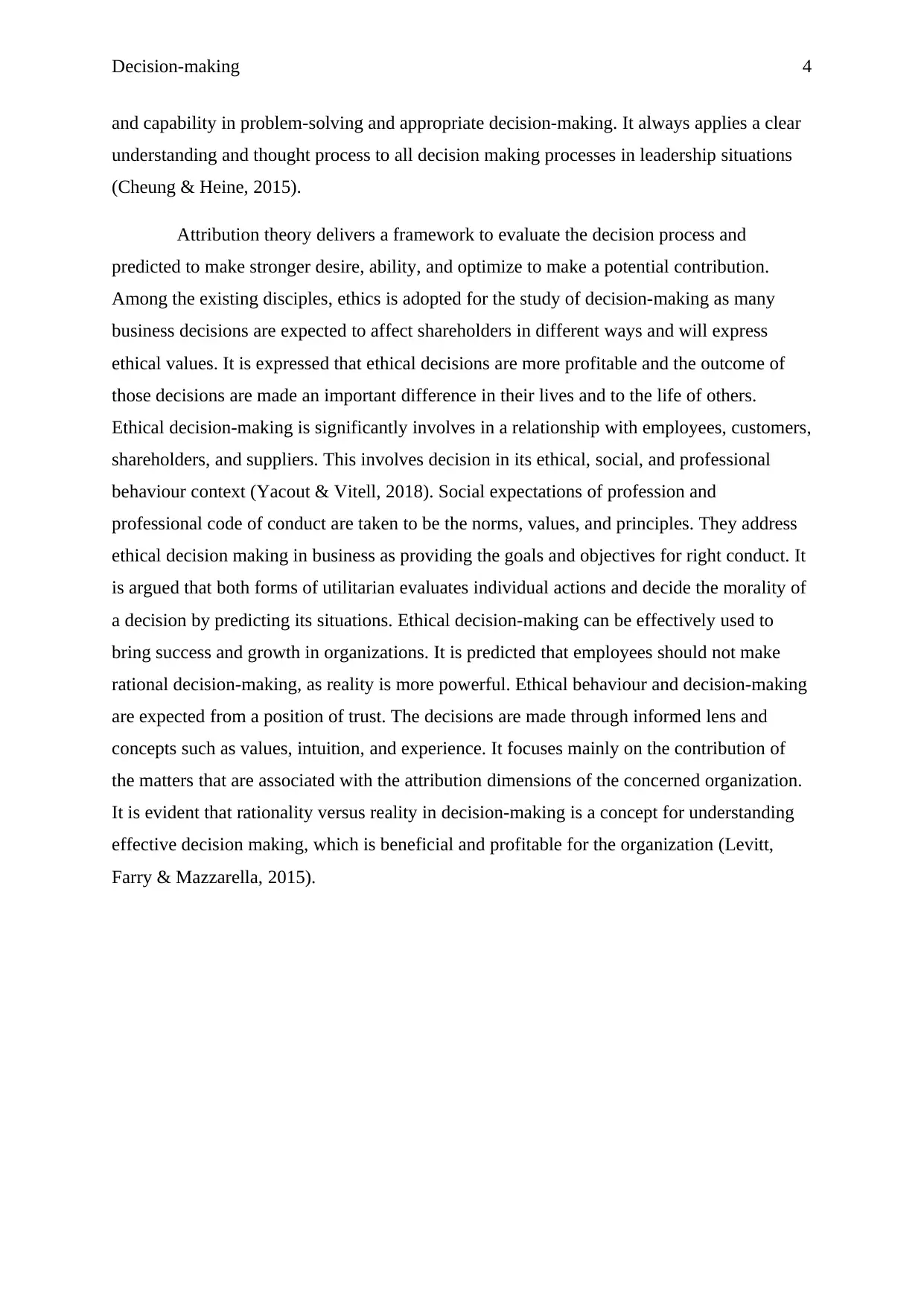
Decision-making 4
and capability in problem-solving and appropriate decision-making. It always applies a clear
understanding and thought process to all decision making processes in leadership situations
(Cheung & Heine, 2015).
Attribution theory delivers a framework to evaluate the decision process and
predicted to make stronger desire, ability, and optimize to make a potential contribution.
Among the existing disciples, ethics is adopted for the study of decision-making as many
business decisions are expected to affect shareholders in different ways and will express
ethical values. It is expressed that ethical decisions are more profitable and the outcome of
those decisions are made an important difference in their lives and to the life of others.
Ethical decision-making is significantly involves in a relationship with employees, customers,
shareholders, and suppliers. This involves decision in its ethical, social, and professional
behaviour context (Yacout & Vitell, 2018). Social expectations of profession and
professional code of conduct are taken to be the norms, values, and principles. They address
ethical decision making in business as providing the goals and objectives for right conduct. It
is argued that both forms of utilitarian evaluates individual actions and decide the morality of
a decision by predicting its situations. Ethical decision-making can be effectively used to
bring success and growth in organizations. It is predicted that employees should not make
rational decision-making, as reality is more powerful. Ethical behaviour and decision-making
are expected from a position of trust. The decisions are made through informed lens and
concepts such as values, intuition, and experience. It focuses mainly on the contribution of
the matters that are associated with the attribution dimensions of the concerned organization.
It is evident that rationality versus reality in decision-making is a concept for understanding
effective decision making, which is beneficial and profitable for the organization (Levitt,
Farry & Mazzarella, 2015).
and capability in problem-solving and appropriate decision-making. It always applies a clear
understanding and thought process to all decision making processes in leadership situations
(Cheung & Heine, 2015).
Attribution theory delivers a framework to evaluate the decision process and
predicted to make stronger desire, ability, and optimize to make a potential contribution.
Among the existing disciples, ethics is adopted for the study of decision-making as many
business decisions are expected to affect shareholders in different ways and will express
ethical values. It is expressed that ethical decisions are more profitable and the outcome of
those decisions are made an important difference in their lives and to the life of others.
Ethical decision-making is significantly involves in a relationship with employees, customers,
shareholders, and suppliers. This involves decision in its ethical, social, and professional
behaviour context (Yacout & Vitell, 2018). Social expectations of profession and
professional code of conduct are taken to be the norms, values, and principles. They address
ethical decision making in business as providing the goals and objectives for right conduct. It
is argued that both forms of utilitarian evaluates individual actions and decide the morality of
a decision by predicting its situations. Ethical decision-making can be effectively used to
bring success and growth in organizations. It is predicted that employees should not make
rational decision-making, as reality is more powerful. Ethical behaviour and decision-making
are expected from a position of trust. The decisions are made through informed lens and
concepts such as values, intuition, and experience. It focuses mainly on the contribution of
the matters that are associated with the attribution dimensions of the concerned organization.
It is evident that rationality versus reality in decision-making is a concept for understanding
effective decision making, which is beneficial and profitable for the organization (Levitt,
Farry & Mazzarella, 2015).
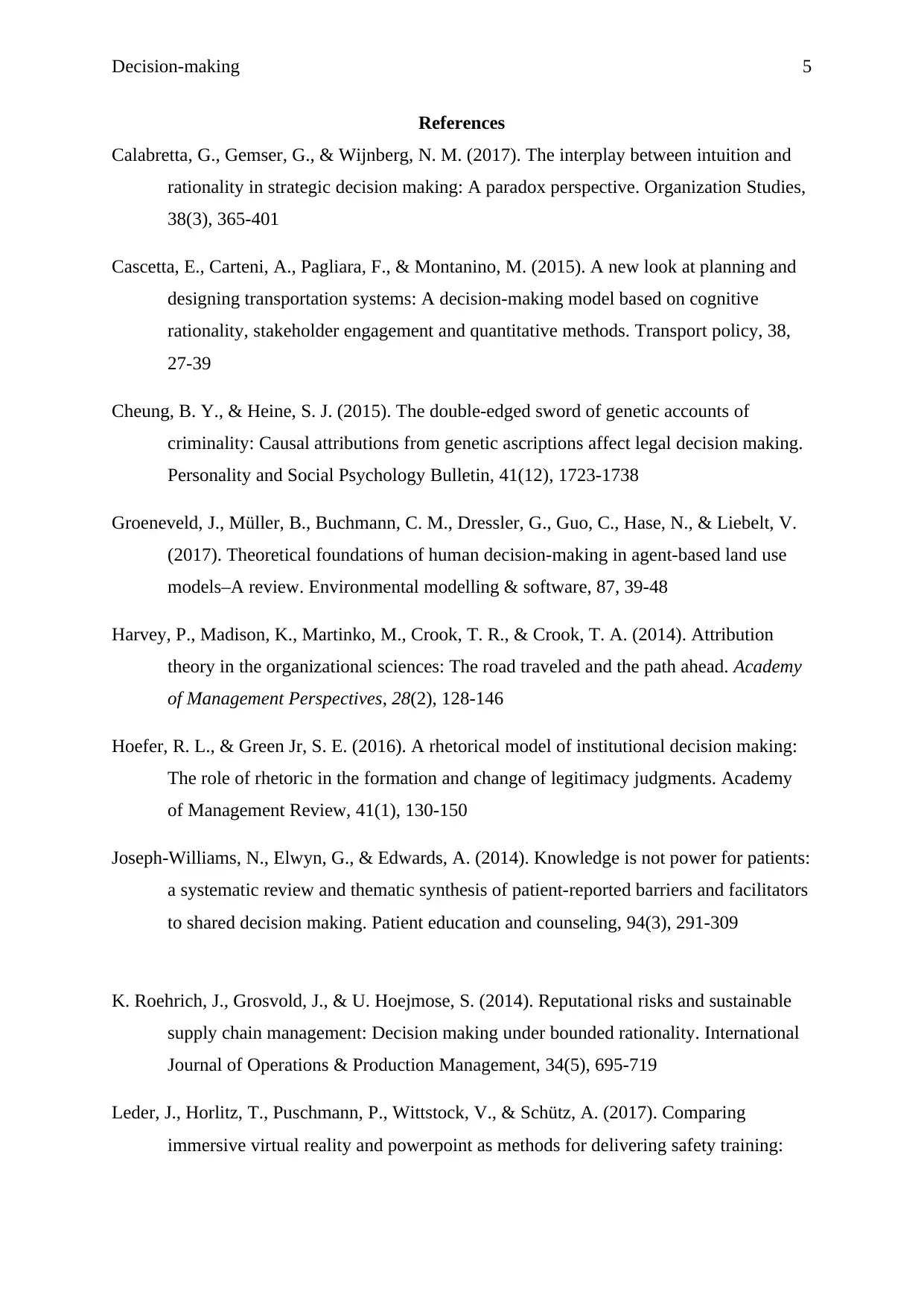
Decision-making 5
References
Calabretta, G., Gemser, G., & Wijnberg, N. M. (2017). The interplay between intuition and
rationality in strategic decision making: A paradox perspective. Organization Studies,
38(3), 365-401
Cascetta, E., Carteni, A., Pagliara, F., & Montanino, M. (2015). A new look at planning and
designing transportation systems: A decision-making model based on cognitive
rationality, stakeholder engagement and quantitative methods. Transport policy, 38,
27-39
Cheung, B. Y., & Heine, S. J. (2015). The double-edged sword of genetic accounts of
criminality: Causal attributions from genetic ascriptions affect legal decision making.
Personality and Social Psychology Bulletin, 41(12), 1723-1738
Groeneveld, J., Müller, B., Buchmann, C. M., Dressler, G., Guo, C., Hase, N., & Liebelt, V.
(2017). Theoretical foundations of human decision-making in agent-based land use
models–A review. Environmental modelling & software, 87, 39-48
Harvey, P., Madison, K., Martinko, M., Crook, T. R., & Crook, T. A. (2014). Attribution
theory in the organizational sciences: The road traveled and the path ahead. Academy
of Management Perspectives, 28(2), 128-146
Hoefer, R. L., & Green Jr, S. E. (2016). A rhetorical model of institutional decision making:
The role of rhetoric in the formation and change of legitimacy judgments. Academy
of Management Review, 41(1), 130-150
Joseph-Williams, N., Elwyn, G., & Edwards, A. (2014). Knowledge is not power for patients:
a systematic review and thematic synthesis of patient-reported barriers and facilitators
to shared decision making. Patient education and counseling, 94(3), 291-309
K. Roehrich, J., Grosvold, J., & U. Hoejmose, S. (2014). Reputational risks and sustainable
supply chain management: Decision making under bounded rationality. International
Journal of Operations & Production Management, 34(5), 695-719
Leder, J., Horlitz, T., Puschmann, P., Wittstock, V., & Schütz, A. (2017). Comparing
immersive virtual reality and powerpoint as methods for delivering safety training:
References
Calabretta, G., Gemser, G., & Wijnberg, N. M. (2017). The interplay between intuition and
rationality in strategic decision making: A paradox perspective. Organization Studies,
38(3), 365-401
Cascetta, E., Carteni, A., Pagliara, F., & Montanino, M. (2015). A new look at planning and
designing transportation systems: A decision-making model based on cognitive
rationality, stakeholder engagement and quantitative methods. Transport policy, 38,
27-39
Cheung, B. Y., & Heine, S. J. (2015). The double-edged sword of genetic accounts of
criminality: Causal attributions from genetic ascriptions affect legal decision making.
Personality and Social Psychology Bulletin, 41(12), 1723-1738
Groeneveld, J., Müller, B., Buchmann, C. M., Dressler, G., Guo, C., Hase, N., & Liebelt, V.
(2017). Theoretical foundations of human decision-making in agent-based land use
models–A review. Environmental modelling & software, 87, 39-48
Harvey, P., Madison, K., Martinko, M., Crook, T. R., & Crook, T. A. (2014). Attribution
theory in the organizational sciences: The road traveled and the path ahead. Academy
of Management Perspectives, 28(2), 128-146
Hoefer, R. L., & Green Jr, S. E. (2016). A rhetorical model of institutional decision making:
The role of rhetoric in the formation and change of legitimacy judgments. Academy
of Management Review, 41(1), 130-150
Joseph-Williams, N., Elwyn, G., & Edwards, A. (2014). Knowledge is not power for patients:
a systematic review and thematic synthesis of patient-reported barriers and facilitators
to shared decision making. Patient education and counseling, 94(3), 291-309
K. Roehrich, J., Grosvold, J., & U. Hoejmose, S. (2014). Reputational risks and sustainable
supply chain management: Decision making under bounded rationality. International
Journal of Operations & Production Management, 34(5), 695-719
Leder, J., Horlitz, T., Puschmann, P., Wittstock, V., & Schütz, A. (2017). Comparing
immersive virtual reality and powerpoint as methods for delivering safety training:
⊘ This is a preview!⊘
Do you want full access?
Subscribe today to unlock all pages.

Trusted by 1+ million students worldwide
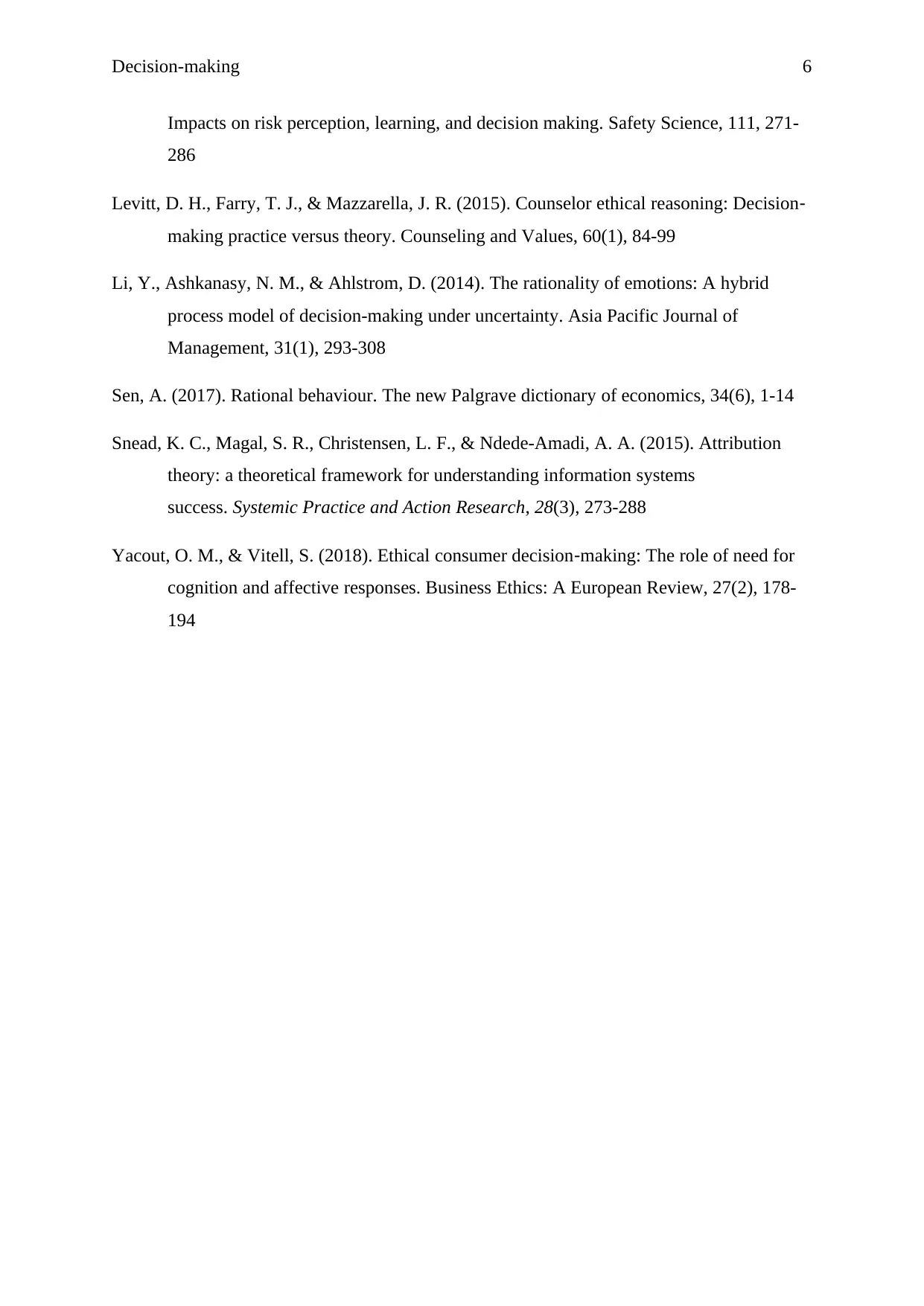
Decision-making 6
Impacts on risk perception, learning, and decision making. Safety Science, 111, 271-
286
Levitt, D. H., Farry, T. J., & Mazzarella, J. R. (2015). Counselor ethical reasoning: Decision‐
making practice versus theory. Counseling and Values, 60(1), 84-99
Li, Y., Ashkanasy, N. M., & Ahlstrom, D. (2014). The rationality of emotions: A hybrid
process model of decision-making under uncertainty. Asia Pacific Journal of
Management, 31(1), 293-308
Sen, A. (2017). Rational behaviour. The new Palgrave dictionary of economics, 34(6), 1-14
Snead, K. C., Magal, S. R., Christensen, L. F., & Ndede-Amadi, A. A. (2015). Attribution
theory: a theoretical framework for understanding information systems
success. Systemic Practice and Action Research, 28(3), 273-288
Yacout, O. M., & Vitell, S. (2018). Ethical consumer decision‐making: The role of need for
cognition and affective responses. Business Ethics: A European Review, 27(2), 178-
194
Impacts on risk perception, learning, and decision making. Safety Science, 111, 271-
286
Levitt, D. H., Farry, T. J., & Mazzarella, J. R. (2015). Counselor ethical reasoning: Decision‐
making practice versus theory. Counseling and Values, 60(1), 84-99
Li, Y., Ashkanasy, N. M., & Ahlstrom, D. (2014). The rationality of emotions: A hybrid
process model of decision-making under uncertainty. Asia Pacific Journal of
Management, 31(1), 293-308
Sen, A. (2017). Rational behaviour. The new Palgrave dictionary of economics, 34(6), 1-14
Snead, K. C., Magal, S. R., Christensen, L. F., & Ndede-Amadi, A. A. (2015). Attribution
theory: a theoretical framework for understanding information systems
success. Systemic Practice and Action Research, 28(3), 273-288
Yacout, O. M., & Vitell, S. (2018). Ethical consumer decision‐making: The role of need for
cognition and affective responses. Business Ethics: A European Review, 27(2), 178-
194
1 out of 7
Related Documents
Your All-in-One AI-Powered Toolkit for Academic Success.
+13062052269
info@desklib.com
Available 24*7 on WhatsApp / Email
![[object Object]](/_next/static/media/star-bottom.7253800d.svg)
Unlock your academic potential
Copyright © 2020–2025 A2Z Services. All Rights Reserved. Developed and managed by ZUCOL.





